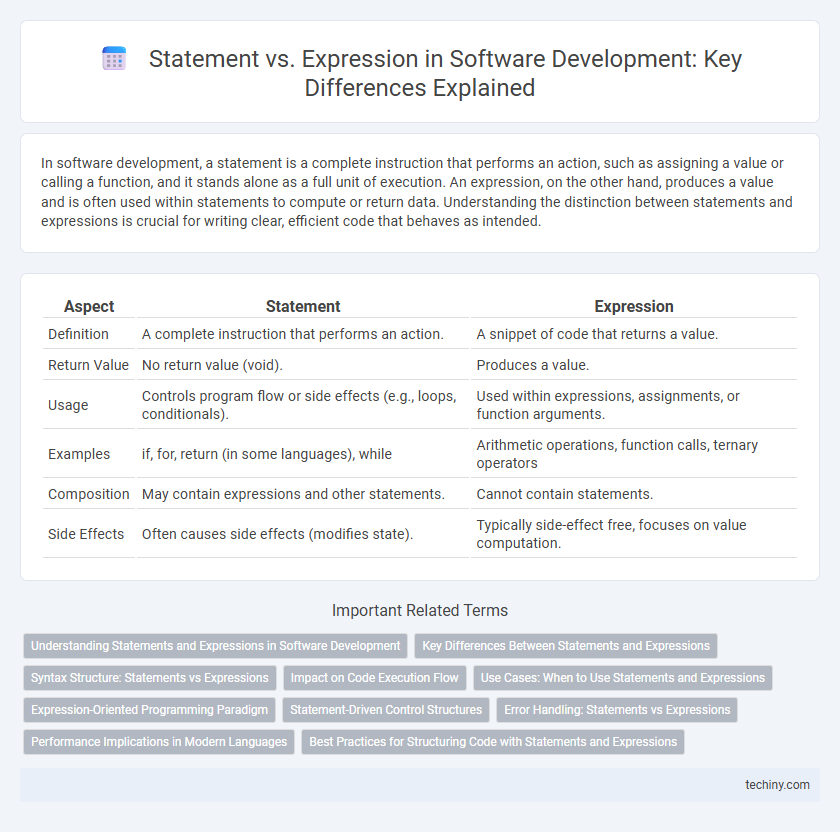In software development, a statement is a complete instruction that performs an action, such as assigning a value or calling a function, and it stands alone as a full unit of execution. An expression, on the other hand, produces a value and is often used within statements to compute or return data. Understanding the distinction between statements and expressions is crucial for writing clear, efficient code that behaves as intended.
Table of Comparison
| Aspect | Statement | Expression |
|---|---|---|
| Definition | A complete instruction that performs an action. | A snippet of code that returns a value. |
| Return Value | No return value (void). | Produces a value. |
| Usage | Controls program flow or side effects (e.g., loops, conditionals). | Used within expressions, assignments, or function arguments. |
| Examples | if, for, return (in some languages), while | Arithmetic operations, function calls, ternary operators |
| Composition | May contain expressions and other statements. | Cannot contain statements. |
| Side Effects | Often causes side effects (modifies state). | Typically side-effect free, focuses on value computation. |
Understanding Statements and Expressions in Software Development
Statements in software development are complete instructions that perform actions or control program flow, such as loops, conditionals, and variable declarations. Expressions evaluate to a value and are composed of variables, operators, and function calls, often used within statements to compute data. Understanding the distinction between statements and expressions is crucial for writing efficient code and debugging complex algorithms effectively.
Key Differences Between Statements and Expressions
Statements perform actions and control the flow of a program, often including declarations, loops, and conditionals, whereas expressions evaluate to a value and can be used within statements. Expressions always produce a result and can be assigned to variables or passed as arguments, while statements do not return values and instead execute commands or alter program state. Understanding the distinction improves code readability and debugging by clearly separating executable instructions from evaluative constructs.
Syntax Structure: Statements vs Expressions
Statements in software development perform actions and typically end with a semicolon; they include control flow constructs like if-else or loops that do not return values. Expressions are syntactic units that produce values and can be composed of variables, operators, function calls, or literals; they can be part of statements or exist independently. Understanding the syntax structure distinction is crucial, as expressions can be embedded within statements, allowing for concise and efficient code formulation.
Impact on Code Execution Flow
Statements directly control the flow of code execution by performing actions such as loops, conditionals, or variable declarations, influencing how and when code runs. Expressions evaluate to a value and can be embedded within statements, enabling dynamic computation without altering the overall execution structure. Understanding the distinction between statements and expressions enhances code readability and execution predictability in software development.
Use Cases: When to Use Statements and Expressions
Statements are used for controlling program flow and performing actions like assignments, loops, and conditionals, making them essential in scenarios requiring state changes or complex logic. Expressions compute and return values, making them ideal for calculations, data manipulation, and embedding within other expressions or statements. Use statements when you need to execute commands or control structures, and use expressions when you require a value to be produced, such as in function arguments or variable assignments.
Expression-Oriented Programming Paradigm
Expression-oriented programming treats all constructs as expressions that return values, enabling more concise and flexible code compared to statement-based paradigms. This approach allows developers to compose complex operations through nested expressions, enhancing code readability and maintainability. Key languages supporting expression-oriented paradigms include Scala, Kotlin, and functional programming languages like Haskell and Lisp.
Statement-Driven Control Structures
Statement-driven control structures in software development dictate the flow of execution by using statements such as if, for, while, and switch to control decision-making and iteration. These structures rely on statements that perform actions or change control flow without returning a value, distinguishing them from expressions which evaluate to produce values. Understanding the distinction between statements and expressions is crucial for mastering control flow and writing efficient, readable code.
Error Handling: Statements vs Expressions
In software development, statements dictate actions such as assignments or control flow, while expressions evaluate to values, making error handling in expressions more seamless through constructs like try-catch blocks or conditional evaluation. Expressions enable more concise error management by embedding handling logic directly where values are computed, reducing the need for verbose statement-based error checks. Leveraging expressions for error handling enhances code readability and robustness by localizing error information and minimizing side effects during evaluation.
Performance Implications in Modern Languages
Statements and expressions differ in execution and performance, where expressions often enable better optimization by modern compilers due to their ability to produce values and be composed within other expressions. Expressions can reduce runtime overhead by facilitating inlining and constant folding, whereas statements typically represent an action or control flow with potentially less opportunity for such optimizations. Modern languages like JavaScript, Python, and functional languages leverage expressions to enhance performance through lazy evaluation and short-circuiting, improving runtime efficiency.
Best Practices for Structuring Code with Statements and Expressions
Effective software development relies on clear distinctions between statements and expressions to create maintainable code. Statements perform actions and control flow without returning values, while expressions evaluate to produce values, enabling concise and readable logic. Adopting best practices involves minimizing side effects in expressions, using statements to structure control flow, and favoring expressions for value computations to enhance code clarity and reduce errors.
Statement vs Expression Infographic

 techiny.com
techiny.com